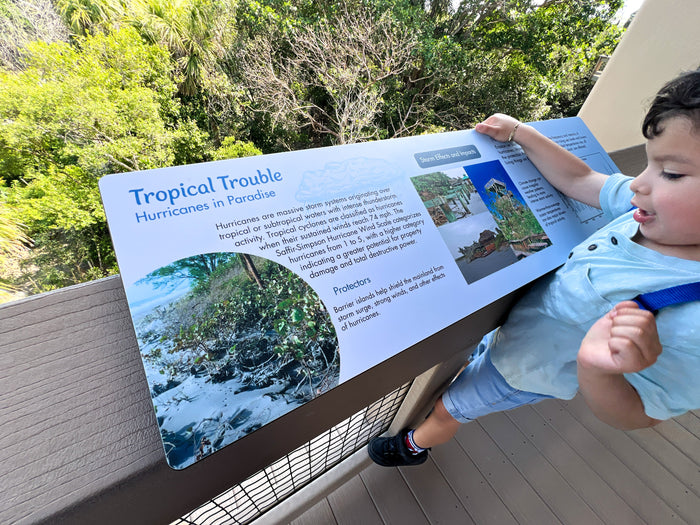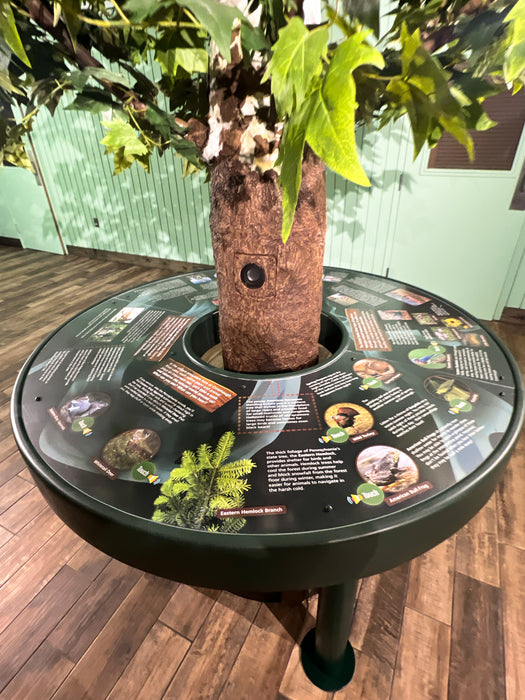Drawing to Bronze: An Artistic Collaboration for Painted Hand Pueblo

A sketch became a 3D print. A 3D print became bronze. Here’s how a MICA student’s artwork turned into a tactile, touchable interpretive element for Painted Hand Pueblo.

A sketch became a 3D print. A 3D print became bronze. Here’s how a MICA student’s artwork turned into a tactile, touchable interpretive element for Painted Hand Pueblo.

When you climb the new Gumbo Limbo Observation Tower in Boca Raton, you’re not just gaining a view—you’re taking a guided tour through the science and stories of Florida’s barrier‑island coast. Atomic Carrots partnered with the City of Boca Raton and the Gumbo Limbo Nature Center to design, fabricate, and install a complete interpretive experience along the tower’s landings. Ten panels—five traditional waysides and five hands‑on interactives—plus three rugged, touchable resin models turn the vertical journey into an outdoor classroom where visitors can see, touch, and discover what makes this shoreline so dynamic.

Each landing introduces a chapter in the tower’s storyline. The five 12" × 40" wayside panels deliver clear, concise content and beautiful visuals that set the scene, while the five 12" × 40" interactive panels invite people to “learn by doing.” Together, the two track types create a cadence: first orienting visitors to a topic, then letting them explore cause‑and‑effect through a simple interaction. Families, field‑trip groups, and casual strollers alike can move at their own pace—pausing to test an idea, flipping a reveal, and then looking out to compare the lesson with the landscape stretching in every direction.
Outdoor exhibits have to survive sun, salt, and steady traffic. That’s why all graphics were produced on exterior‑grade Custom High‑Pressure Laminate (CHPL) from iZone. The panels are paired with HDPE components and outdoor‑rated hardware that resist corrosion and swelling. Edges are eased for comfort; surfaces are matte to cut glare at midday; and all touchpoints are designed to be field‑serviceable so staff can keep the experience in excellent shape. The tactile models are sealed with a UV‑stable protective finish to guard against fading and abrasion, supporting daily hands‑on use in South Florida’s bright conditions.
Every illustration was created in‑house by Atomic Carrots. We developed a custom shoreline map of Boca Raton and drew a library of local building silhouettes and coastal cues—dune lines, mangrove forms, and architectural profiles—to echo the views from the tower. The result is a visual language that feels unmistakably local. Even without reading a word, visitors can tell they’re encountering stories anchored to this exact stretch of coast. Colors reference the muted tones of maritime forests and near‑shore waters, with high‑contrast accents reserved for key terminology and callouts to keep information readable in bright sun.

The tower’s “low‑tech” interactives use simple mechanics—lift‑flaps, sliders, and windows—to create a “Peekaboo” moment of discovery. That small act of opening something turns a quick glance into an engaged read: visitors predict what’s behind, lift to check their guess, and then connect the explanation to the surrounding view. These reveals help unpack ideas like storm structure, sediment movement, habitat zoning, and the ways people shape shorelines. The interfaces are deliberately tactile and intuitive for all ages, durable enough for thousands of cycles, and designed so that each reveal adds a purposeful insight rather than novelty for novelty’s sake.

To translate abstract concepts into memorable encounters, we produced three touchable resin models. Each piece began as a 3D model, was 3D printed, then molded in silicone, cast in durable resin, and hand‑painted to bring form and texture to life. The models let visitors feel the contours of coastal features and marine biology concepts—an especially valuable layer for younger learners and guests who benefit from tactile interpretation. After painting, the pieces were sprayed with a UV‑protective topcoat to keep colors stable and surfaces resilient outdoors.

Behind the scenes, the project followed a tight fabrication workflow: CAD layouts and proofing, color‑accurate print production, CHPL routing and edge finishing, fit‑checking with HDPE spacers, and hardware staging with labeled kits for efficient installation. On site, the team sequenced work so landings could remain accessible, aligning panels for consistent sightlines and confirming comfortable reach ranges for children and adults. Each interactive mechanism is accessible for maintenance, and moving parts are designed with replaceable wear components to extend service life.
Interpretive text favors plain language and a crisp hierarchy to support quick comprehension in a public space. Type sizes and line lengths were selected for outdoor legibility; graphics use high‑contrast focal colors sparingly so the most important information pops even at noon. Tactile elements are placed at comfortable reaches, and the interactive motions are light enough for small hands while still feeling sturdy. Alt‑text and descriptive captions are provided in the digital versions so the content remains accessible across platforms.
As guests climb, they connect the tower’s sweeping views to the stories on the panels—how barrier islands form and shift, why mangroves and maritime forests protect coastlines, and how storms reshape beaches. The mix of waysides, interactives, and tactile models caters to different learning styles, creating an experience that’s both place‑based and hands‑on. Many visitors linger to compare what they’ve just learned with the real‑world cues around them—an effective recipe for retention and for inspiring stewardship of coastal ecosystems.

This project reflects close coordination among the Gumbo Limbo Nature Center team, the City of Boca Raton, and Atomic Carrots’ designers and fabricators. We’re grateful for the on‑site staff and volunteers who helped us integrate interpretation with the tower’s architecture and visitor flow, and to iZone for reliable CHPL production that stands up to the elements. Projects like this succeed when everyone—from content writers to installers—pulls in the same direction, and this collaboration set a high bar for quality and care.

If you’re headed to Boca Raton, put the Gumbo Limbo Observation Tower on your list. Climb the stairs, flip a window, run your hands over the tactile models, and then look out across the very habitats you’ve just explored. It’s a rare moment when design, craft, and place align so neatly—and we’re proud to have helped shape that experience.

—
Scope at a glance: five 12" × 40" wayside panels, five 12" × 40" interactive panels, and three touchable resin models. Materials include iZone CHPL and HDPE components, with UV‑protected finishes for outdoor durability.

At Atomic Carrots, we believe education is most impactful when interactive experiences bring learning to life. Our recent project for Conemaugh River Lake Visitor Center in Indiana County, Pennsylvania, exemplifies this belief perfectly. We designed, fabricated, and installed an immersive interpretive exhibit dedicated to enhancing visitors' understanding and appreciation of the rich local ecosystem.

Central to the exhibit is a beautifully crafted American Sycamore tree, encircled by informative tabletop-style interpretive panels. These panels showcase the incredible biodiversity of the region, including native plants and animals, while also highlighting the U.S. Army Corps of Engineers' dedication to environmental stewardship.
But what truly makes this exhibit stand out is the innovative integration of our very own EchoSlate technology. EchoSlate employs touch-activated sensors embedded seamlessly into vibrant graphic panels, allowing visitors to explore sounds from local wildlife like deer, bluebirds, ospreys, turkeys, squirrels, katydids, bullfrogs, and spring peepers with just a gentle touch.
Unlike traditional buttons, EchoSlate's touch-activated system provides a more hygienic, inclusive, and streamlined user experience. The non-glare acrylic surface not only integrates beautifully with the artistic elements of the exhibit but is also easy to clean and maintain.

The exhibit effectively communicates essential ecological themes, including the roles of pollinators, the management of invasive species, the restoration of natural habitats, and the preservation of cultural resources. By experiencing these themes interactively, visitors gain a deeper appreciation and understanding of the local ecosystem and the importance of ongoing conservation efforts.

By blending tactile interactivity with informative storytelling, we've created an environment at Conemaugh River Lake that appeals to visitors of all ages and interests. This approach ensures that everyone, from curious children to seasoned nature enthusiasts, walks away with enriched knowledge and a memorable experience.
We invite you to experience the beauty and diversity of the Conemaugh River Lake ecosystem firsthand. Whether you're exploring the interactive sounds, learning about habitat conservation, or simply enjoying the stunning visual displays, there’s something inspiring waiting for you.
Atomic Carrots continues to be proud of our role in creating experiences that educate, engage, and inspire communities through thoughtful, creative exhibit design.